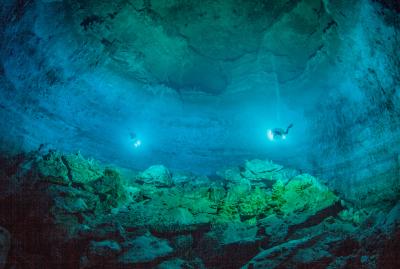The discovery of a near-complete human skeleton in a watery cave in Mexico is helping scientists answer the question, “Who were the first Americans?” The finding, reported in the 16 May issue of the journal Science, sheds new light on a decades-long debate among archaeologists and anthropologists.
Deciphering the ancestry of the first people to populate the Americas has been a challenge.
On the basis of genetics, modern Native Americans are thought to descend from Siberians who moved into eastern Beringia (the landmass connecting Asia and North America) between 26,000 and 18,000 years ago. These people, the earliest Americans, then spread southward.
Despite widespread support for this idea, the ancestry of the earliest Americans is still debated because the facial features of the oldest American skeletons don’t look much like those of modern Native Americans.
“Modern Native Americans closely resemble people of China, Korea, and Japan,” James Chatters, lead author on the study, said, “but the oldest American skeletons do not.” They have longer, narrower crania than later Native Americans, and smaller, shorter faces, too — more closely resembling modern peoples of Africa, Australia, and the Southern Pacific Rim. “This has led to speculation that perhaps the first Americans and Native Americans came from different homelands,” Chatters continued, “or migrated from Asia at different stages in their evolution.”
Complicating the puzzle, it’s been very difficult to find intact Paleoamerican skeletons for study.
“Paleoamerican skeletons are rare for several reasons,” Chatters explained. “The people themselves were few; they were highly nomadic and seem to have buried or cremated the dead where they fell, making the locations of graves unpredictable; also, geologic processes have destroyed or deeply buried their graves.”
Meanwhile, those skeletal remains that have been unearthed are lacking, often only fragments, and most estimated to be younger than 10,000 years old. (The earliest Americans reached the continent farther back in time than that.)
Now, however, Chatters and colleagues report the discovery of a near-complete Late Pleistocene-age human skeleton. It was hidden deep in a submerged chamber in the Sac Actun cave system on Mexico’s Eastern Yucatán Peninsula.
“Hoyo Negro is a more than 100-foot-deep, bell-shaped, water-filled void about the size of a professional basketball arena deep inside a drowned cave system,” Chatters said. “Only technical cave divers can reach the bottom. First they must climb down a 30-foot ladder in a nearby sinkhole; then they swim along 200 feet of tunnel to the pit rim before making a final 100-foot drop. The divers are the astronauts of this project; we scientists are their mission control.”
Like nearby caves, Hoyo Negro was accessible only via sinkhole; people and animals fell in and were trapped. Then, starting about 10,000 years ago, global glaciers melted, filling the caves with water. In addition to the near-complete human skeleton, the researchers found the remains of 26 large mammals, including extinct taxa such as sabertooths and gomphotheres.
The nearly-intact skeleton was that of a small human female about 15 or 16 years old. Based on radiocarbon dating of tooth enamel and analyses of mineral deposits on her bones, the researchers inferred her remains to be at least 12,000 years old.
She possesses the unique craniofacial morphology of the earliest Americans, but to understand more about her ancestry and its potential linkage to modern Native Americans, the researchers extracted DNA from one of her molars. “We tried a DNA extraction on the outside chance some fragments might remain,” Chatters said. “I was shocked when we actually got intact DNA.”
He and colleagues analyzed the girl’s mitochondrial DNA (mtDNA), a useful tool for examining the relatedness of populations. Their analysis revealed a haplotype common to modern Native Americans, subhaplogroup D1. This genetic signature occurs only in the Americas, likely having developed in Beringia after populations there split from other Asians.
The sample shows that individuals of the Pleistocene era with Beringian-derived mtDNA traveled far and wide through the Americas, all the way down to Mexico, for example.
Critically, it shows that despite differences in craniofacial form, this early American woman was related to modern Native Americans; the differences in craniofacial form are probably best explained as evolutionary changes that happened after the divergence of Beringians from their Siberian ancestors, the authors say.
Their work suggests that America was not colonized by separate migration events from different parts of Eurasia. Rather, the earliest Americans represent an early population expansion out of Beringia. This aligns with the hypothesis that both Paleoamericans and Native Americans derive from a single source population.
Chatters and colleagues were delighted with their find: “This project is exciting on so many fronts: the beautiful cave, the incredibly well-preserved animal skeletons, the completeness of the human skeleton, the success of our innovative dating approach. But for me,” he said, “what is most exciting is that we finally have an answer, after 20 years, to a question that has plagued me since my first look at Kennewick Man: ‘Who were the first Americans?'”

